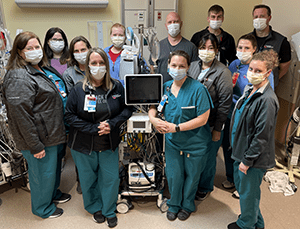Newsroom
Cincinnati Children’s reaches milestone of 1,000 ECMO patients treated
The ECMO program was among the first in the country when it was established in 1985
Monday, May 02, 2022
Cincinnati Children’s Hospital Medical Center announces it has treated its 1,000th patient using an extracorporeal membrane oxygenation (ECMO) machine. ECMO is a form of life support used for babies, children, and adults with life-threatening heart or lung issues, or both, that allows the body to rest and recover by doing the work of these organs.
“Cincinnati Children’s was one of the original ECMO programs in the United States, and continues to be a leader today, including being part of the international team that set standards for ECMO usage in patients with COVID-19,” Jason Frischer, MD, director of the ECMO Program at Cincinnati Children’s, says. “ECMO has saved numerous lives here in Cincinnati – from severely ill neonates to children with respiratory disease or sepsis failing medical management in the Pediatric Intensive Care Unit, to those with heart disease who require extra support. The ECMO team takes care of the sickest of the sick, and the members who comprise the team are the best of the best! I speak for the entire team that we are honored to have had the opportunity to take care of the first 1,000 kids who require ECMO, and we look forward to taking care of the next 1,000.”
An ECMO machine is used by placing tubes into large blood vessels found in the neck, groin, or chest, and connecting them to the machine which moves blood from the patient (extracorporeal) to an artificial lung (membrane) or heart pump. The membrane lung adds oxygen and removes carbon dioxide (oxygenation) and then returns the blood back to the patient. An ECMO machine can support a patient for weeks or months and is used in a variety of clinical settings and situations such as the Neonatal Intensive Care Unit, post-operative care, patients who need circulation reestablished by means other than CPR or medication, and those who need to be bridged to Ventricular Assist Devices (VADs) or lung transplantation.
ECMO also plays a critical role in Cincinnati Children’s End-stage Lung Failure Program, which is the first of its kind in the United States. This program uses ECMO and other means of advanced lung support to provide care for patients from infants to young adults who have acute lung failure from a variety of reasons – chronic lung failure, or combined heart-lung failure – giving hope to those who seemingly had no other options for survival. In many cases, patients in need of Cincinnati Children’s unique expertise in ECMO and end-stage lung disease are transferred from other institutions, sometimes across the world, and given a second chance at life.
“ECMO is the backbone of the End-Stage Lung Failure Program which allows our team to deliver cutting-edge care to the most critically ill children in the world,” Don Hayes, MD, co-director of the End-Stage Lung Failure Program and medical director of Lung Transplant at Cincinnati Children’s, says. “Our comprehensive team and innovative program have no equal as we attempt to support these severely ill children with ECMO while rehabilitating them at the same time and determining if they will recover with their own lungs or need a lung transplant.”
Once a patient’s heart and/or lungs recover enough to function independently, they will be slowly weaned off ECMO until they are well enough to support themselves with their own heart and/or lungs. This can take days or even weeks depending on a patient’s condition and the sickest patients may even require extensive rehabilitation. This careful process is made possible because of Cincinnati Children’s world-renowned experts and a multidisciplinary approach where specialists from several disciplines, each with their own unique perspective, coordinate every step of a patient’s care journey and tailor all aspects of their care. The goal is to assist in the recovery of all patients with lung injury with their own lungs, but the dedicated care team will help children of all ages to survive even if lung transplantation is needed.
In addition, ECMO is a tool used by the nationally recognized Cincinnati Children’s Ventricular Assist Device Program. A VAD is a small pump that sits inside or outside the body that helps the heart pump blood and can be used by a patient for the rest of their life or as a bridge to heart transplant. VADs require an evaluation process and surgical implantation, meaning ECMO is critical for those patients needing immediate heart support. Once the patient is transitioned from ECMO to a VAD the child may be able to be discharged home to wait for a donor heart. As technology continues to mature, more children will be able to be sent home on life saving cardiac equipment.
“ECMO is literally a life saver. It allows children who are having a cardiac arrest to be saved so that we can hopefully eventually wean them off ECMO or transition them to a VAD if the heart does not recover,” David Morales, MD, Director of Congenital Heart Surgery at Cincinnati Children’s says. “If a patient is on a VAD, we can rehabilitate them to recovery or bridge them to transplant. In the case of the latter, children on VAD who reach transplant have the same outcomes as a child who never needed a VAD before transplant.”
Contact Information
Bo McMillan
bo.mcmillan@cchmc.org




